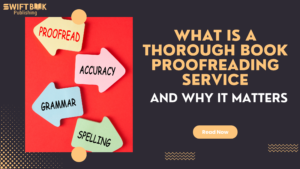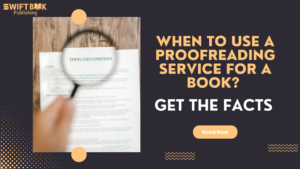As a new author, is this your first time publishing a book? The thrill of seeing your work in print comes with the complexities, often leaving first-time authors wondering where to start. How do you choose between self-publishing and traditional publishing? How do you ensure your manuscript is polished and ready for submission? And, just as important, how do you market yourself as a new author?
This guide is designed to clear up the confusion and lead you step-by-step through the process, whether you’re hoping for a traditional deal or planning to self-publish. By the end, you’ll have a clearer picture of the path forward, equipped to make informed choices and confident in your journey.
1. Assessing Your Publishing Goals
Clarifying your objectives is essential before diving into the publishing process. Understanding your publishing goals will help you understand the options, from how much creative control you want to how much time and resources you’re willing to invest.
Understanding Your Objectives
If you are publishing a book for the first time, think about why you wrote your book.
- Is it a passion project you want to share with a small community?
- Are you aiming for widespread readership?
- Knowing your purpose and identifying your target audience will help guide your publishing choices.
For instance, if you want broad reach but have a limited budget, certain self-publishing platforms might work best. If you’re seeking industry credibility, traditional publishing may be worth exploring, though it may take more time and effort.
How To Get A Book Published For The First-Time UK?
The choice between self-publishing and traditional publishing is big, each offering unique pros and cons. Here’s a breakdown to help you decide:
Self-Publishing
Self-publishing gives you total control. You’re in charge of the creative aspects, from cover design to pricing. Platforms like Swift Kindle Direct Publishing (KDP), IngramSpark, and Kobo make self-publishing accessible to first-time authors. However, you’re also responsible for editing, design, and marketing costs. Royalties in self-publishing are higher, with platforms like Swift KDP offering up to 70% royalties.
Traditional Publishing
Traditional publishing offers the credibility of an established publisher and provides access to professional editors, designers, and marketing teams. However, it’s competitive, especially for new authors. In traditional publishing, you’ll typically need a literary agent to submit your work to larger publishers. In return, the royalties are lower, usually between 8 and 15%. Traditional publishers in the UK, like Penguin Random House UK, Hachette, and HarperCollins UK, generally don’t accept unsolicited submissions, so going through an agent is a common route.
Comparing Publishing Routes
| Feature | Traditional Publishing | Self-Publishing |
| Control | Limited | Complete |
| Cost | Publisher covers costs | Author covers costs |
| Profit Share | Smaller percentage | Higher percentage |
| Speed of Publication | Slower | Faster |
| Distribution | Wider | Limited unless marketed |
2. Preparing Your Manuscript for Submission
Once you’ve decided on a publishing path, it’s time to ensure your manuscript is polished, professional, and ready for submission. Your manuscript’s quality is crucial whether you’re submitting to an agent, publisher, or self-publishing platform.
Editing and Proofreading
Professional editing is an investment worth making. Even the most talented writers benefit from a second pair of eyes. There are three main types of editing to consider:
- Developmental Editing: Focuses on the overall structure, ensuring your story flows and the characters are well-developed.
- Copyediting: Corrects grammar, punctuation, and syntax errors.
- Proofreading: A final check to catch any lingering mistakes.
For first-time authors, hiring a professional editor for developmental editing and copyediting is highly recommended. Freelance platforms like Reedsy and Fiverr can connect you with experienced editors, and many editors offer packages specifically for first-time authors.
Formatting Requirements
Proper formatting is essential when submitting to publishers, literary agents, or self-publishing platforms. Each has its own formatting standards, but a few universal practices include:
- Double-spaced lines
- Times New Roman or Arial font, 12-point size
- Indented paragraphs, no extra spaces between paragraphs
If you’re self-publishing, pay attention to eBook-specific formatting like Kindle or EPUB, which differ from print formatting. Tools like Scrivener or Adobe InDesign can simplify the formatting process, or you can hire a formatting specialist.
Beta Readers and Feedback
Before sending your manuscript to agents or publishers if this is your first time publishing a book, consider feedback from beta readers. Beta readers are individuals who represent your target audience and can give honest feedback on your story’s strengths and areas for improvement. Platforms like Goodreads and Reddit offer communities where you can connect with potential beta readers. Their insights can help you refine your manuscript, strengthening its appeal to potential publishers and agents.
3. Building an Author Platform
Establishing an author platform is vital for first-time authors. A strong online presence can help you connect with readers, market your book, and build credibility.
Why Platform Matters
Agents and eBook publishers look for authors who actively engage with their audience. Even self-published authors benefit from an established online platform, as it can boost sales and grow readership. An author platform goes beyond social media; it’s your entire digital presence, including your website, blog, and engagement on platforms like Goodreads.
Setting Up Your Website and Social Media
Your website acts as a professional portfolio. Include a bio, details about your book, and links to your social media. Essential social media platforms for authors include Instagram, Twitter, and Facebook, where you can connect with your target readers. For nonfiction authors, LinkedIn can also be a valuable platform.
Growing Your Audience
To build a following, provide content that resonates with your readers. Share excerpts from your book, insights on your writing process, and engage with readers’ questions. Joining online book communities or creating content on Medium and Wattpad can also help grow your audience organically. A dedicated email list, built through your website or platforms like Mailchimp, is a valuable asset for reaching readers directly when your book is released.
4. Exploring Traditional Publishing Options
Traditional publishing can be competitive, but the structure and support it provides are valuable for new authors. Here’s how to get started if you’re exploring traditional publishing options.
Finding and Querying Literary Agents
Literary agents play a crucial role in connecting authors with traditional publishers. Agents review your work, offer editorial guidance, and negotiate publishing contracts. To find a suitable agent, research agencies that represent your genre and accept first-time authors. Start with the Association of Authors’ Agents (AAA) for agents in the UK or sites like QueryTracker and AgentQuery.
When reaching out, craft a compelling query letter that includes:
- An engaging hook: Open with a line that captures your book’s unique premise.
- Brief summary: Summarize your plot in one to two paragraphs.
- Author bio: Highlight relevant background, including writing achievements or unique experiences that inform your work.
Researching Publishers Accepting First-Time Authors
Some smaller publishers and independent presses accept unsolicited manuscripts, particularly those in genres like romance, science fiction, or fantasy. Look for publishers that support new authors, such as Bloomsbury Spark, Chronicle Books, and Orenda Books. Read their submission guidelines carefully, as they often specify formatting preferences and genres.
Preparing a Book Proposal or Synopsis
A book proposal is essential for nonfiction authors aiming to publish traditionally. It includes an overview of your book, target audience, and competitive analysis. Fiction writers may need to submit a synopsis, a one to two-page summary of your plot, highlighting major plot points and the story’s resolution. If possible, work with an experienced editor or fellow writers to review your proposal or synopsis, as they can provide valuable feedback to make it more compelling.
5. Understanding the Self-Publishing Process
If you’ve chosen to self-publishing for publishing a book for the first time, the good news is that you’ll have full creative control and direct access to your readers.
However, you’ll also be responsible for all aspects of publishing, from design to marketing.
Choosing a Self-Publishing Platform
Popular self-publishing platforms include Swift Kindle Direct Publishing (KDP), IngramSpark, and Draft2Digital. Each offers unique advantages:
- Swift KDP: The most widely used platform, KDP provides global reach and the potential to earn up to 70% royalties. You can publish both eBooks and print versions, and Swift’s market dominance means your book will have high visibility.
- IngramSpark: Ideal for authors wanting wide distribution to bookstores and libraries, IngramSpark provides access to a large network but has setup fees.
- Draft2Digital: Known for its user-friendly interface, Draft2Digital allows you to distribute your book to various eBook retailers, including Apple Books and Kobo, with no upfront costs.
Compare each platform’s royalties, distribution channels, and pricing to find the best fit for your goals.
Designing a Book Cover
Your book cover is one of the first things potential readers will see, so it’s essential to invest in quality design. For self-publishing authors, hiring a professional cover designer is worth the investment to ensure your book looks polished and market-ready. Freelance sites like Fiverr and 99designs have designers specializing in book covers, or you can work with a platform like Reedsy, which connects authors with vetted book designers.
Pricing and Royalty Considerations
Pricing is a crucial element of your book’s success. Research similar books in your genre to set a competitive price, keeping in mind that lower prices can attract more readers for new authors. Most platforms will show you potential royalties based on different price points, so experiment with what works best for your target audience and publishing goals.
6. Marketing Your Book
Marketing is essential for any book’s success, especially for self-published authors without a publisher’s support. Fortunately, there are numerous strategies you can use to get your book noticed.
Utilizing Social Media and Content Marketing
Social media remains one of the most effective ways to market your book. Use platforms like Twitter, Instagram, and TikTok to connect with potential readers and share your journey as an author. Content marketing is also powerful; creating blogs, newsletters, or YouTube videos about writing can help attract an audience interested in your work.
Email Marketing
Email marketing is highly effective because it gives you a direct line to your readers. Set up an email list on your website using services like Mailchimp or ConvertKit, and start sharing updates, exclusive excerpts, and book-related content. As your list grows, you’ll have a group of engaged readers ready for your launch.
Promotions and Giveaways
Hosting giveaways or discount promotions can help you gain traction, especially if you’re a new author. Offer the first few chapters for free, or use limited-time price reductions to encourage downloads and reviews. Sites like BookBub, Goodreads, and Kindle Countdown Deals provide options to run these promotions, expanding your reach and attracting more readers.
7. Preparing for Book Launch
Launching your book is an exciting milestone, but it’s essential to approach it with a solid plan to maximize its success.
Building Buzz Pre-Launch
Create anticipation by sharing your launch date on social media and in your email newsletter. Reveal your cover, share behind-the-scenes snippets, and encourage readers to pre-order your book if it’s available. Consider a blog tour or virtual book tour, where bloggers and reviewers feature your book on their sites.
Getting Reviews
Book reviews can be the deciding factor for many readers. Reach out to book bloggers, reviewers, and your beta readers for honest reviews that can be posted on Swift, Goodreads, and other platforms. Reviews increase your book’s visibility and credibility, encouraging more readers to give it a chance.
Organizing a Launch Event
If feasible, consider hosting a book launch event. This can be a live event at a local bookstore or a virtual event on platforms like Facebook Live or Zoom. It’s a great way to celebrate your accomplishment, share your story, and interact directly with readers.
8. Post-Launch Strategies
Once your book is live, the marketing doesn’t stop. Consistent engagement with your audience will keep your book relevant and maintain sales momentum.
Ongoing Promotion and Advertising
Consider paid advertising options to keep your book visible, such as Swift Ads, Facebook Ads, or BookBub Ads. Set a budget and monitor your ad performance, adjusting as needed to optimize your reach. Even small ad campaigns can significantly boost your book’s exposure when done strategically.
Building Your Next Steps as an Author
If you’re planning future books, keep your readers updated on your progress. Many authors build loyal followings by sharing updates, upcoming titles, and snippets of their next work. Think about creating a series if your first book allows for it, as sequels often attract returning readers.
Gathering Feedback for Future Works
Feedback from readers is invaluable for improving as a writer. Pay attention to reviews and comments to understand what resonated with readers and what didn’t. This feedback can inform your future projects, helping you craft books that better meet your audience’s expectations.
Starting the Author’s New Journey
Congratulations on taking your first steps toward becoming a published author. This journey is about more than just releasing a book; it’s a transformative process that can open doors to new opportunities, relationships, and achievements.
Embrace both the challenges and the successes, as each one will shape your growth as a writer and creator.
- Build a Writing Community: Connecting with other writers, authors, and readers will give you invaluable support and insight. Consider joining writing groups, attending literary events, or participating in online author communities. These connections can offer encouragement, accountability, and practical advice throughout your publishing journey.
- Stay Open to Learning: The publishing industry is constantly evolving, especially with the growing influence of digital platforms and self-publishing. Stay informed on industry trends, marketing strategies, and technological advancements to keep your approach fresh and relevant.
- Pace Yourself for the Long-Term: Publishing a book is an important step, but it’s often just the beginning of a long and fulfilling journey. Give yourself time to learn, experiment, and grow as an author. Success doesn’t happen overnight, but with dedication and persistence, you can build a sustainable and impactful writing career.
Key Takeaways for New Authors:
- Take time to understand your publishing options and choose the best route for your goals.
- Prepare your manuscript meticulously, with professional editing and formatting.
- Build your author platform early on to establish a readership and support future book launches.
- Invest in your launch strategy with thoughtful planning to maximize your book’s initial impact.
- Continue engaging with your audience and stay adaptable to the evolving publishing landscape.
In time, these steps will help turn your dreams of becoming a published author into reality. With your book out in the world, you’ll be equipped not only with experience but also with the resilience to tackle whatever comes next. So, go forward with confidence, knowing that each chapter of your journey brings you closer to the future you’ve envisioned as a published author.
Conclusion: Your Path to a Published Author
Getting a book published for the first time is an incredible achievement. The journey may seem overwhelming, but with careful planning, perseverance, and a clear strategy, you can confidently understand each step. Whether you choose self-publishing or traditional publishing, remember that each successful author started where you are now: facing the unknown, putting their work out into the world, and ultimately achieving their dream.
As you move forward, use this guide as your roadmap. Celebrate each milestone, from completing your manuscript to seeing your book in readers’ hands. With each step, you’re not just creating a book; you’re building a career as a published author.
Frequently Asked Questions
1. Do I need a literary agent to publish my book traditionally?
Yes, for most traditional publishers, a literary agent is necessary, as they handle the submission process and negotiate contracts on behalf of the author. However, some smaller publishers accept unsolicited manuscripts directly from authors.
2. How much does it cost to self-publish a book?
Costs vary depending on the level of professional assistance, such as editing, cover design, and marketing. For a quality self-published book, expenses typically range from $500 to $5,000, depending on your choices and services used.
3. How can I increase my chances of getting a literary agent?
Craft a compelling query letter, research agents who specialize in your genre, and follow each agent’s submission guidelines closely. Attending writing conferences and participating in online pitch events can also increase your chances of making connections.
4. How important is building an author platform before publishing?
An author platform is crucial, especially for first-time authors, as it helps establish a reader base and demonstrates to agents or publishers that there’s an existing interest in your work. Start by creating an author website and active social media profiles to engage with your potential audience early on.







